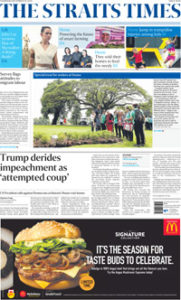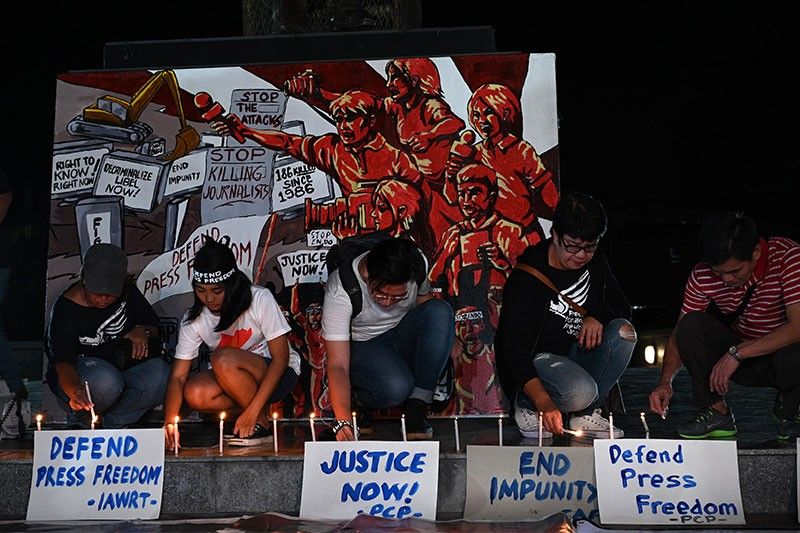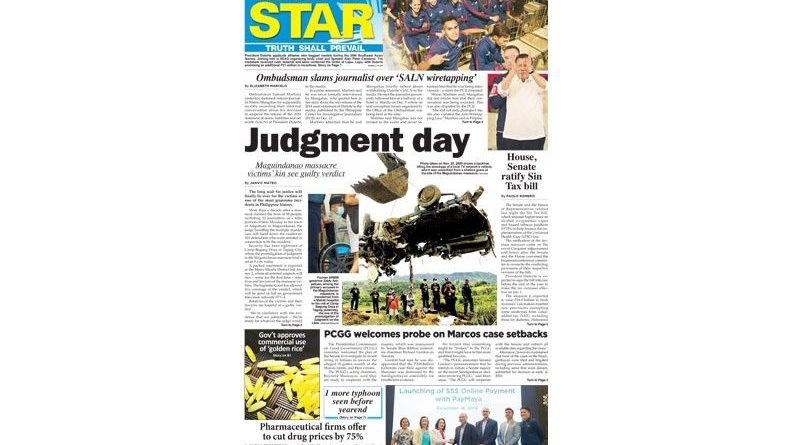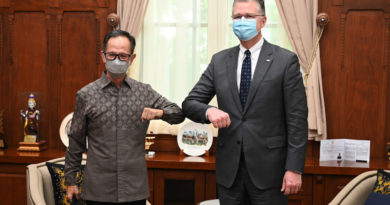ASEANEWS HEADLINE: MANILA- Judgment day- Maguindanao massacre verdict: Zaldy Ampatuan, Andal Jr. found guilty of murder













BREAKING NEWS:
Maguindanao massacre verdict: Zaldy Ampatuan, Andal Jr. found guilty of murder

Relatives and supporters of victims of the country’s worst political massacre light candles during a vigil at a park in Manila on December 18, 2019, on the eve of a court verdict in the case. The alleged masterminds of the Philippines’ worst political massacre will learn their fate December 19 when a Manila court issues its verdict, in a test of the justice system for a nation with a deep-seated culture of impunity.
.
MANILA, Philippines — More than a decade since 58 people were killed in the worst case of election-related violence in Philippine history, Quezon City Regional Trial Court Branch 221 found Datu Andal Ampatuan Jr. and his brother Zaldy Ampatuan guilty.
They are sentenced to reclusion perpetua without parole.
Members of the Ampatuan political clan are among the over 100 individuals who were tried for the Nov. 23, 2009 massacre, when relatives of then Maguindanao gubernatorial candidate Esmael Mangudadatu and a convoy of 32 journalists were stopped and executed by gunmen.

. .
The bodies of the victims were found buried in the town of Ampatuan in Maguindanao province.

. .
Arrest and trial
The massacre prompted then President Gloria Macapagal-Arroyo to declare a state of emergency in Maguindanao and Sultan Kudarat provinces and in Cotabato City on November 24 to “prevent and suppress the occurrence of similar other incidents of lawless violence.”
Martial law was declared in parts of Maguindanao on December 4 and lifted on December 12 as members of the Ampatuan clan, Arroyo’s political allies, were taken into custody.
Andal Jr. and Zaldy are the primary accused in the case and are in government custody. Datu Sajid Islam Ampatuan was allowed to post bail in 2015.
The trial, which began in January 2010, included 134 witnesses for the prosecution, with key witnesses telling the court “they heard the Ampatuans plan the killing as early as July 2009, and as late as November 19, 2009, or just four days before the massacre,” according to a briefer by the Freedom for Media, Freedom for All coalition.

. .
Prosecution witnesses also said they saw Datu Unsay (Andal Jr.) kill the victims and order his men to “hurry up” in burying the bodies, which were later found in a mass grave in Ampatuan town in Maguindanao.
The defense, meanwhile, presented witnesses from the Ampatuan municipal government who testified that Datu Unsay was in a meeting at the municipal hall during the time of the massacre. Datu Unsay also testified that he was not at the massacre site when it happened.
The defense also said that no forensic evidence was presented to directly link Datu Unsay to the killings.

. .
Delays
The case suffered delays from the sheer number of people and records involved and from procedural requirements like bail hearings for 70 of the detained suspects.
“It was only on May 30, 2017, seven years after the trial began, that Judge [Jocelyn] Solis-Reyes denied Datu Unsay’s petition for bail,” FMFA said in its briefer, adding Judge Solis-Reyes also had to face nine motions for her to recuse herself from the trial.
“The numerous motions for reconsideration, the time given for the defendants to find new lawyers, as well as ‘delaying tactics of the defense’, tied up the case during the last three years,” FMFA said.

. .
The case was submitted for decision on August 22 and a verdict was expected in November, in time for the tenth year since the massacre. Judge Solis-Reyes the Supreme Court for 30 more days, however, citing the “voluminous records” in the case.
After years of hearings, the judge had to go through 165 volumes of records on the trial, 65 volumes of stenographic notes, eight volumes of the prosecution’s documentary evidence, and the testimony of 357 witnesses.
As the trial the Regional Trial Court comes to a close, the case could go on longer before the verdict becomes final and executory at the Supreme Court.

. .

All photographs, news, editorials, opinions, information, data, others have been taken from the Internet..aseanews.net









